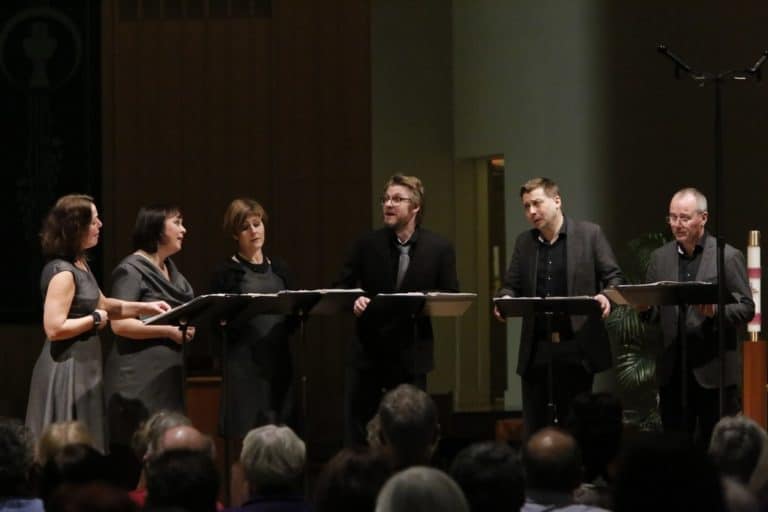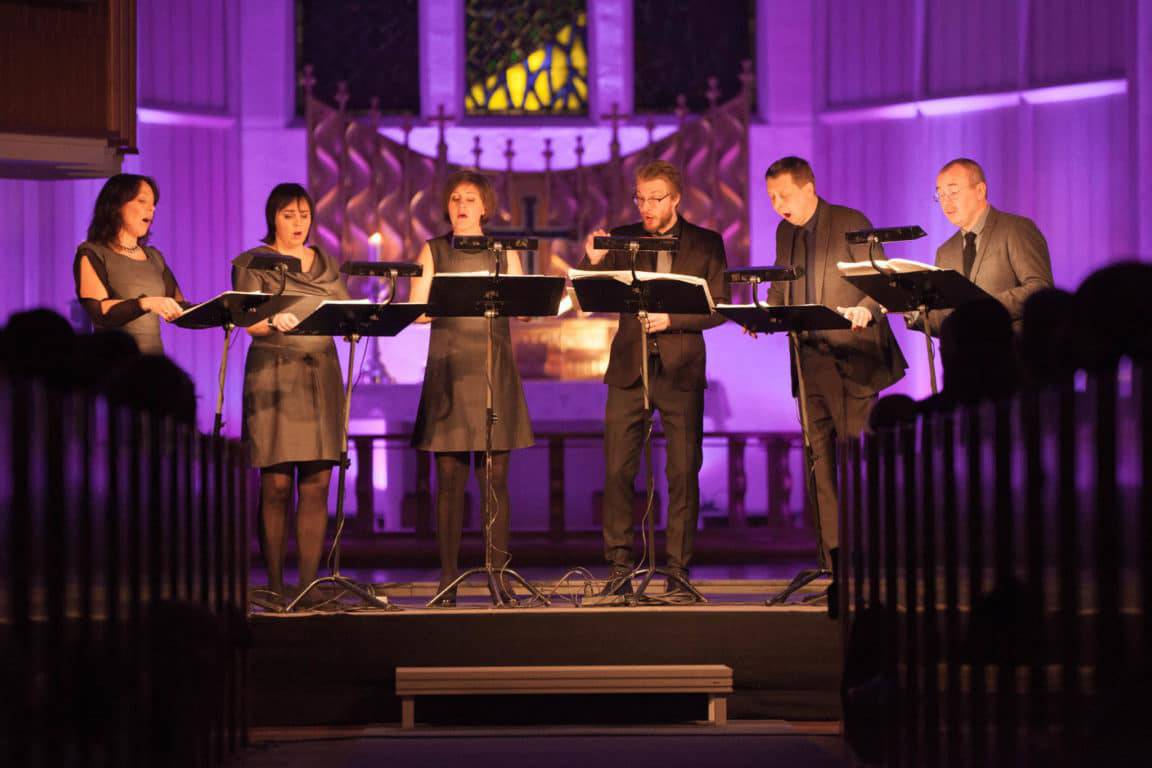On February 17, the audience at Portland’s St. Philip Neri Church experienced some sounds that many had probably never heard before, at least not from human voices. In their concert presented by Friends of Chamber Music, the three men and three women of Nordic Voices gave us a sonic landscape ranging from luscious Renaissance polyphony to quacks, whistles, groans, and overtone singing, all with great sophistication and ensemble balance. When they did venture into conventional tonality, the a cappella ensemble displayed impeccable intonation.
The programming reflected the sextet’s extensive repertoire, including the contemporary Norwegian composer, Lasse Thoresen, all the way back to the 16th century French composer Clément Janequin. Anyone expecting the usual sacred music of the Lenten season would have been caught off guard, but it is hard to imagine that they wouldn’t have been enchanted.

Nordic Voices is participating in a project to explore new forms of singing in the Concrescence Project, developed by Thoresen and supported by the Norwegian Academy of Music. These vocal methods combine Western classical singing techniques with microtonality and other non-Western methods. Several of their pieces involved overtone singing (also known as “harmonic” singing), in which singers change the shape of the mouth and pharynx to produce more than one pitch at the same time. A Mongolian throat-singer has assisted Nordic Voices in developing their overtone techniques. At times during the concert the singers exhibited unusual mouth shapes, while at other times exquisite sounds emerged from mouths that seemed to be nearly closed. Their extended vocal techniques also included speaking, trilling, and ululation.
In their excellent English, undaunted by an initially balky microphone, group members gave us interesting and useful insights on some of their songs. “Solbøn,” the opening piece by Thoresen, is a prayer for safe-keeping, based on Norwegian folk music. Mezzo-soprano Ebba Rydh sang the melody accompanied by overtone singing from the other members, humming and whistling and building up to a glorious conclusion.
Nordic Voices turned next to György Ligeti’s compositions, which the illustrious 20th century Hungarian composer called “nonsense madrigals,” based on Alice in Wonderland themes. The repetitions of “Cuckoo,” along with many comical phrases, were well articulated and accompanied by expressive body language. These pieces seemed delightfully chaotic, but were obviously beautifully controlled.
The group easily traveled back 400 years to Luca Marenzio’s madrigals from the late Renaissance; their phrasing and dynamics made these old pieces come alive. “Per duo coralli” (For two pearls) gleams with sensuality, living up to Marenzio’s reputation as a word-painter. In the “Ecco” songs, “Ecco che’l ciel” (Look, how the sky) and “Ecco che mill’augei” (Hear, thousands of birds), you could see as well as hear the singers conveying the composer’s call for our attention.
The Marenzio madrigals were followed by a lively tribute to spring, love, and birdsong by Clément Janequin, which Nordic Voices calls an “ornithologist’s wet dream,” ending in a “jubilant cacophonic climax of the forest in spring.” Contrary to the accepted practice for Renaissance madrigals, Nordic Voices failed to sing the leading tones in cadences one-half step below the tonic, to the displeasure of a member of the Reed College music faculty I chatted with at intermission. Later, when I brought it up to the group, they said they knew that was customary, but they just preferred it their way — not surprising for such an iconoclastic group of performers.
After the intermission and a tender rendition of a Norwegian lullaby arranged by Nordic Voices baritone Frank Havrøy, mezzo-soprano Rydh announced that the group would deviate for a moment from the program. “We have decided,” she said, “that the acoustic of this room has to be filled with the music of Arvo Pärt.” It was as if the haunting dissonances and soaring harmonies of the great contemporary Estonian composer’s Magnificat were indeed made for this group in this space. There was a long pause before the audience was willing to break the spell with applause.
Visibly moved by Pärt’s music, Havrøy needed to collect himself before he could announce the next “nonsense,” by Geoffredo Petrassi: three beautifully executed pieces of pure silliness based on limericks by Edward Lear. The “dolorous Man of Cape Horn” featured heads drooping heavily over collapsing music stands, and the “old maid of Stroud/ Who was horribly jammed in a crowd” sounded like a street riot in the making. More birdsong ensued, in the form of a sweet and luscious Ravel song, “Trois beaux oiseaux du Paradis” (Three beautiful birds of Paradise).
The finale was a strange and wonderful contemporary piece by Maja Ratkje, “A Dismantled Ode to the Moral Value of Art.” There was almost no text until the end, and just a hint of a theme from Beethoven’s Ninth Symphony. Much of it consisted of a variety of vocal utterances sounding like cricket trills, snoring, water dripping into a bucket, croaking frogs, bird chirps, sighs, and whistles. It seemed odd to watch the singers turn pages, and I wondered what the notation must look like. The piece ended with a touching repetition of a line (“everything’s gonna be all right”) from a Neil Young song, sung by the baritone seated in the middle, while one by one, all the rest left the stage.
For an encore, Nordic Voices stationed themselves around the church interior and performed a Norwegian lullaby, “Bysjan, bysjan lite bån” (Hush, hush little child), composed by Frank Havrøy. A beautiful example of the group’s extended vocal techniques, it made a fitting end to an extraordinary evening. The harmonic overtones were so ethereal, it was hard to tell where the music was coming from.




